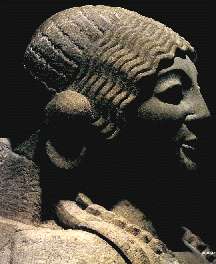|
|

|
|

Historical and Cultural Setting
|
After the collapse of the Hittite empire in c. 1200 BC, which had been the major regime in Late Bronze Age Anatolia, the stage was left open for the rise of new cultures. The beginning of the Iron Age saw the establishment of Neo-Hittite states in the southeast , and at the beginning of the 9th century the Urartians emerged as a major power in the east and northeast. Their history is a tale of clashes with their Assyrians neighbours, but at the same time the three cultures experienced an interchanging of artistic ideas.
The peoples of mainland Greece had begun sending out colonists to the western shores and off-shore islands of Anatolia from perhaps as early as the 11th century onwards, the Aeolian settlers founding cities between the Troad and the Gulf of Smyrna, the Dorians founding six major cities in Caria and the nearby islands of Rhodes and Cos, and the Ionians establishing themselves between the two. Collectively the culture produced by these settlements is often referred to as East Greek, an unsatisfactory term in many ways, but acceptable in respect of their origins and their system of selfgovernment. The Ionian cities were very much at the forefront of developments, and certain traditions and innovations can be pin-pointed as Ionian, but until more definite distinctions can be made, it is generally more appropriate to use the term East Greek, particularly when certain characteristics are seen to be shared by the Ionian and Aeolian cities, for example, and any identification of the inspiration is no more than conjecture. The Phrygians emerge in the 8th century as a unified state which was to dominate the political and cultural scene of inland Anatolia until the early 7th century. The question of their origins and the date of their appearance in Anatolia is an issue which still forms the focus of scholarly debate, as is the question of whether they were partly responsible for the upheavals at the end of the Bronze Age, including the collapse of the Hittite empire, or whether their appearance in Anatolia was a peaceable infiltration. Whatever their origins, there are elements in Phrygian culture which point to the continuation of certain earlier Anatolian cultural traditions. |
The phyrigian capital, Gordion, was on a major route across Anatolia which was at a later date incorporated into the network of the Persian Royal Road. Gordion had obviously been considered a strategic site from Early Bronze Age times, and had been also a Hittite settlement of the 2nd millennium. The Phrygians settled numerous other former Hittite sites, including Bogazkoy and Alacahoyuk. Historical references to the Phrygians in the annals of the Assyrian kings confirm the extent of Phrygian political influence during the last quarter of the 8th century BC. Short inscriptions have survived in the Phrygian script, preserved for example on Phrygian vessels, from which it is clear that Phrygian belongs to the Indo-European family of languages. but the lack of any documents in their own language very much restricts our knowledge of the Phrygians to that derived from the archaeological evidence. At the beginning of the 7th century, c. 696 BC. the Phrygians suffered a major setback at the hands of the Kimmerians, invaders from the north, and the archaeological evidence for devastation and conflagration in the citadel is believed to have been caused by a particularly destructive Kimmerian attack in the first decade of the century. Awer the devastation, during which much of the palace complex was destroyed, Gordion was rebuilt, but never regained its former dominance over central and inland western Anatolia, partly due to the rapid rise to power of the Lydians of the Mermnad dynasty. The Lydians were a western Anatolian people distinguished by language and cultural traditions. Some aspects of Lydian language (a palaic-Anatolian subgroup of Indo-European) and culture were related or shared with those of other Anatolian peoples. like the Carians and Phrygians. Under the kings of the Mermnad dynasty, beginning with Gyges, the Lydians became masters of a western Anatolian empire that extended east to the Halys river (Kizilirmak). The Lydian kingdom existed for a century and a half, and reached its apogee under the last king Kroisos, who was renowned for riches, extravagance, pride, and mercurial fortunes. At the height or his power in 547/6 BC, Kroisos and his empire were conquered by the Persians under their king, Kyros the Great. For more than two centuries thereafter. until Alexander the Great's conquest of 334 BC. Lydia was a province of the Persian empire. |


|

|


This site prepared by Tayfun Kalyoncu on 28.02.1997 and last updated on 01.05.1999.
For any comments and suggestion please send an e-mail using the form at page mailform.html